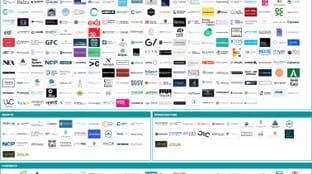
🌏 Who are the Climate Tech Investors?
A new interactive Climate Capital Stack Map
For a lean team, Powerhouse punches well above its weight. It seems like they’re everywhere in the climate tech landscape. W

Emily Kirsch, founder of Powerhouse
For a lean team, Powerhouse punches well above its weight. It seems like they’re everywhere in the climate tech landscape. When we read their high quality Innovation Insights report this week, we decided that it was finally time to understand how Emily Kirsch and her team manage to have so much climate influence, particularly with corporates.
How did Powerhouse first get started?
Back in 2012 I was working at an organization founded by Van Jones. Van was friends with the music icon Prince who helped the company Mosaic get off the ground. With Prince’s support, I worked with Mosaic on their pilot in Oakland and was struck by the fact that there was really no hub for clean energy entrepreneurship in the Bay Area. So in 2013 we launched Powerhouse to provide the customer and capital connections that every clean energy and mobility startup needs.
What’s changed at Powerhouse since 2012?
While we’ve always been about bringing startups, corporates, and investors together, the way that we do that now is very different from what it looked like in our early years. In 2013, we described ourselves as an incubator and accelerator. We ran a 6-month accelerator program for a few years and have since shifted our entire business model. We’ve always been a for-profit company but we now operate as an innovation firm and have also launched a venture fund.
What was the thinking behind the transition from the incubator and accelerator model to being an innovation firm and VC?
First, innovation is everywhere, and we want to see all of it. When you’re a place-based incubator and accelerator, your view may be limited to what’s right in front of you. We wanted to widen that aperture nationally and globally.
Secondly, accelerators are time-bound, and usually run on a 6-12 month cycle, yet those timing constraints are contrary to how venture actually works. With Powerhouse Ventures, which we launched in 2018, we can back the most promising seed stage, software-focused entrepreneurs wherever and whenever we find them.
You work closely with corporates. Can you share more about how you support that side of the ecosystem?
The purpose of partnering with corporates is to help them lead the next century of clean technology innovation. Some of them have been leaders for over 100 years but if they want to be around for the next 100, they need to evolve. Powerhouse works with those who embrace that reality and we help them accelerate their process.
Corporates are hyper curious to see what climate tech founders are doing on the ground. We help them tap into teams and technologies that they otherwise may not find on their own. In doing so, they may become a customer of that startup, invest in them, or even acquire them.
One of the products that we offer to our corporate and investor clients is called an Innovation Insights report which we publish quarterly.
Interesting. Tell us more about the Innovation Insights report?
The goal of the Innovation Insights reports is to 1) give corporates and investors insights into the trends that we’re seeing, often before anyone else and 2) ensure that they are aware of the startups that are most disruptive and relevant to the topics they care most about.
We’ve also quietly been building a database of thousands of startups, corporations, and investors. On the startup side, we’ve been gathering information on what tech they’re building and what it means for the industry. We have a unique perspective on how this data is indicative of trends, and by making this information available to our partners, we can help them build a decarbonized, democratized, and digitized world faster.
Our latest Innovation Insights report covers emissions management and offsets, EV charging, the landscape for fossil fuel companies in the time of COVID, and opportunities unlocked by ultacheap electricity.
What trends are you seeing in the emissions management and offsets space?
The bottom line for emissions management and offsets is that corporates will begin to fully integrate sustainability practices into operational processes and supply chains, making the simple implementation of emissions accounting and management practices increasingly important. When selecting offset projects for direct investment, additionality will be a key differentiating factor as companies consider an expanding array of solutions.
Powerhouse sees opportunities for startups across three segments of emissions management and offsets: (1) Analytics for emissions management, (2) Sourcing of “additional” projects, and (3) Tools that enable the trading of carbon credits. To access a preview of the latest Innovation Insights click here.
To learn more about how Powerhouse works with startups, corporations and investors to change the way we power our world check out Powerhouse and Powerhouse Ventures.
Interested in more content like this? Subscribe to our weekly newsletter on Climate Tech below!

A new interactive Climate Capital Stack Map

Financing around first- or early-of-a-kind project risk

‘Government-enabled, private sector-led’ in action in Washington, DC